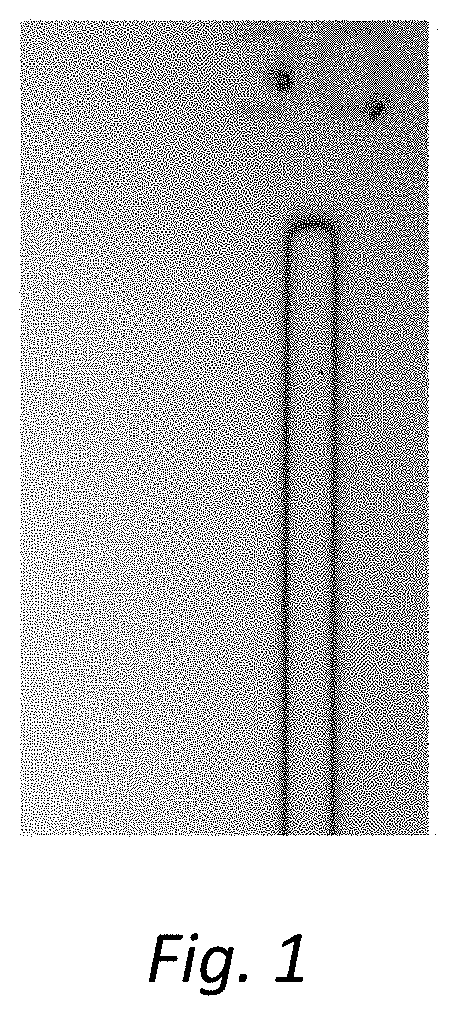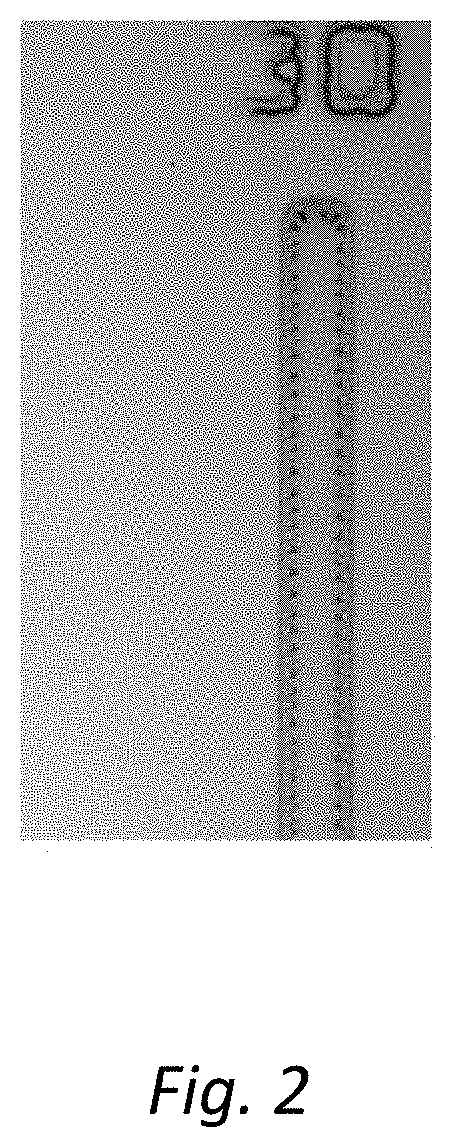Photosensitive resin composition
a technology of resin composition and photosensitive resin, which is applied in the direction of plastic/resin/waxes insulators, instruments, photomechanical equipment, etc., can solve the problems of increasing the density of peripheral wirings, increasing the electrical resistance of the electrode, and corroding parts of metal wirings, so as to prevent the ion migration of the resulting cured product and achieve satisfactory development of the photosensitive resin composition
- Summary
- Abstract
- Description
- Claims
- Application Information
AI Technical Summary
Benefits of technology
Problems solved by technology
Method used
Image
Examples
example 1
[0051]47.8 g of above reactive polymer 1 (solid content concentration of 36.5%); 36 mg of 4-hydroxy-TEMPO [manufactured by Wako Pure Chemical Industries, Ltd., 4HTEMPO (4-hydroxy-2, 2, 6, 6-tetramethylpiperidine-N-oxyl)] as a hindered amine free radical-based stabilizer; 0.29 g of IRGACURE-379 [manufactured by BASF Corp., 2-dimethylamino-2-(4-methyl-benzyl)-1-(4-morpholine-4-yl-phenyl)-butan-1-one] as a photoacid generator; 0.29 g of IRGACURE OXE-01 [manufactured by BASF Corp., 1, 2-octanedione, 1-[4-(phenylthio) phenyl-, 2-(O-benzoyl oxime)]] and 0.29 g of IRGACURE OXE-02 [manufactured by BASF Corp., ethanone, 1-[9-ethyl-6-(2-methylbenzoyl)-9H-carbazol-3-yl]-, 1-(O-acetyl oxime); 5.8 g of KAYARAD DPHA [manufactured by Nippon Kayaku Co., Ltd., dipentaerythritol hexaacrylate] and 5.8 g of Aronix M-520 (manufactured by Toagosei Co., Ltd., polybasic acid-modified acrylic oligomer) as a crosslinking agent; 32.8 g of PGMEA (propylene glycol monomethyl ether acetate) and 6.8 g of PGME (pr...
example 5
Preparing a Comb-Shaped Electrode for the Migration Test
[0060]A substrate, which was sequentially mounted with a silicon nitride film with a film thickness of 1000 nm, a titanium nitride film with a film thickness of 20 nm by sputtering method, and a copper film with a thickness of 300 nm by sputtering method, was prepared on the silicon wafer substrate. In order to remove the copper layer acid value on the surface of the substrate, the substrate was immersed in a 10 wt. % sulfuric acid aqueous solution for one minute at room temperature. The substrate was then washed under a stream of pure water and the surface was dried off. A commercially available resist (LC-135, manufactured by Rohm and Haas Electronic Materials Co., Ltd.) was applied on the substrate by using a spin coater (D-SPIN SK-W60A-AVP, manufactured by SOKUDO Ltd.). The substrate was then prebaked on a hot plate for 90 seconds at 110° C. to obtain a resist film. The thickness of the resist film was measured by an optica...
example 6
[0062]To the substrate fitted with a comb-shaped electrode prepared in Example 5, the photosensitive resin composition prepared in Example 1 was applied using a spin coater (D-SPIN SK-W60A-AVP, manufactured by SOKUDO Ltd.). It was then prebaked on a hot plate (same as above) for two minutes at 90° C. to obtain a photosensitive resin film. The thickness of the photosensitive resin film was measured by an optical interference film thickness meter (manufactured by Lasertec Co., Ltd.). The rotation speed was adjusted such that the film thickness after prebaking becomes 1.8 microns. For the obtained photosensitive resin film, the transfer mask was used to shield the probe mounting position of comb-shaped electrode and other entire surface was exposed. Except for these, the photosensitive resin film was subjected to ultraviolet curing, removal of the surface uncured portion by the development treatment, and baking treatment in the same manner as in Example 1. At this time, the photosensit...
PUM
| Property | Measurement | Unit |
|---|---|---|
| acid value | aaaaa | aaaaa |
| acid value | aaaaa | aaaaa |
| acid value | aaaaa | aaaaa |
Abstract
Description
Claims
Application Information
 Login to View More
Login to View More - R&D
- Intellectual Property
- Life Sciences
- Materials
- Tech Scout
- Unparalleled Data Quality
- Higher Quality Content
- 60% Fewer Hallucinations
Browse by: Latest US Patents, China's latest patents, Technical Efficacy Thesaurus, Application Domain, Technology Topic, Popular Technical Reports.
© 2025 PatSnap. All rights reserved.Legal|Privacy policy|Modern Slavery Act Transparency Statement|Sitemap|About US| Contact US: help@patsnap.com


